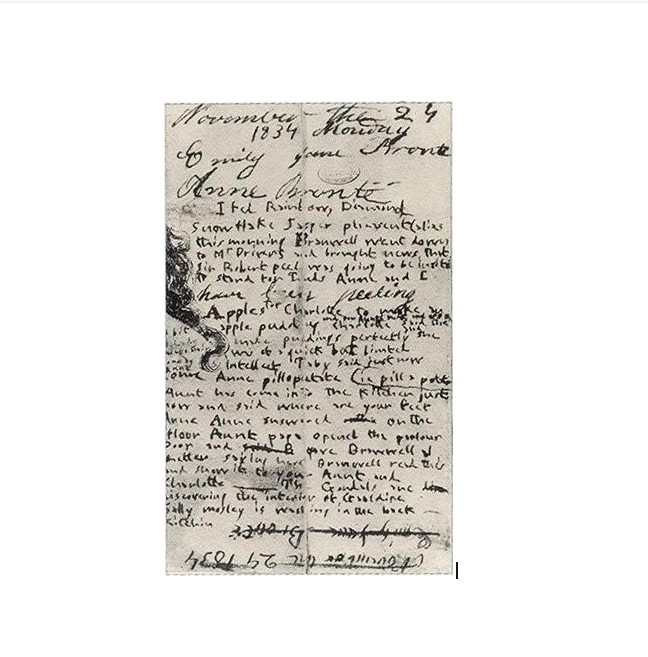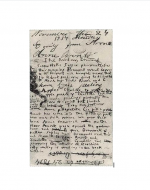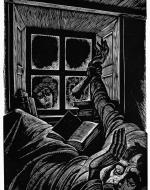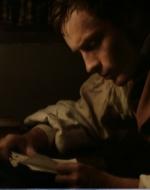Created by Amelia Urquhart on Thu, 11/19/2020 - 12:29
Description:
A diary is perhaps the most personal object a person could own. It is like an insight into a person’s brain, every page revealing a deep desire or concern. Victorian women who enjoyed writing, as the Brontë sisters did, needed a kind of creative outlet to express their raw emotions. Especially because female authors had difficulty publishing, writing in her diary would have been important and meaningful to Victorian women. In Anne's and Emily's novels, diaries are crucial to the fabric of the plot, highlighting their importance to women in society and to the Brontës themselves.
The First Diary Paper of Anne & Emily Brontë, 1834
This is a page out of a diary shared by Emily and Anne Brontë that was written in 1834 when the sisters were 16 and 14, respectively. Although it is signed by both sisters, Emily is the writer and narrator of the entries, but she only mentions activities and events that she and Anne experienced together. This diary paper illustrates the everyday lives of the sisters, but truly gives an insight into their personalities and who they truly were.
A diary entry dated to November 24, 1834 reads:
“I fed Rainbow, Diamond, Snowflake, Jasper, pheasant this morning. Branwell went down to Mr Drivers and brought news that Sir Robert Peel was going to stand for Leeds. Anne and I have been peeling apples for Charlotte to make an apple pudding and for Aunt’s nuts and apples. Charlotte said she made puddings perfectly and she was of a quick but limited intellect. Tabby said just now come Anne pilloputate (ie pill a potato). Aunt has come into the kitchen just now and said, ‘where are your feet Anne?’ Anne answered, ‘on the floor Aunt’. Papa opened the parlour door and gave Branwell a letter saying, ‘here Branwell read this and show it to your Aunt and Charlotte’. The Gondals are discovering the interior of Gaaldine, Sally Mosley is washing in the back kitchen.
Here we can see both Emily and Anne’s sense of humor displayed through Anne’s jokes and Emily’s loving mockery of of the accent of their servant, Tabby Aykroyd. We can also see that they are concerned about politics and world affairs, as they mention the name of a former Prime Minister of the UK (Sir Robert Peel). This entry lets us in on the everyday life of the Brontës in Haworth and also tells us quite a bit about the true natures of the sisters.
Fritz Eichenberg, "Catherine at the Window, for Wuthering Heights, Random House edition, 1943.
This image portrays the scene in which Catherine’s ghost comes to the window where Lockwood is residing, and she begins to call to him,“‘Let me in—let me in... I’m come home. I’d lost my way on the moor” (Norton 5th ed. 21). Prior to this event, Lockwood is reading Catherine’s Bible, which was covered in writing unrelated to the texts. He describes the format as “some were detached sentences; other parts took the form of a regular diary, scrawled in an unformed, childish hand” (16). We can infer from this quote that Catherine’s Bible serves as a diary for her, and this is confirmed when Lockwood reads the passages that describe the routines of her daily life and her feelings towards everyone in the house. The Bible, or "diary," is pictured here in Lockwood’s hand as Catherine comes to frighten him at the window. This is significant to the image, and we can assume that something in the diary causes Catherine to appear. Whether she is upset that Lockwood is invading her privacy, or perhaps opening the diary causes her to appear, we know that either way, the diary means something to Catherine, and Lockwood reading it has something to do with her return.
Screenshot of "Gilbert Markham reading Helen Huntingdon's Diary" played by Toby Stephens in The Tenant of Wildfell Hall, 1996 BBC Production.
In this scene, we see Gilbert Markham reading Helen Graham’s diary after she gives it to him in order to explain why she can’t be with him. Helen giving Gilbert the diary is important both physically and metaphorically. Physically, the diary explains Helen’s past, illuminating her issues with trust and her secretive nature, but metaphorically, when Helen gives Gilbert the diary, she is offering him her heart. The diary is full of Helen's most well-kept secrets and by giving it to Gilbert, she is risking both her and her son's safety. We know Helen is not a foolish woman. In relinquishing the diary to Gilbert, Helen is trusting him with her and her son’s life, knowing that he will protect her and keep her safe. It is no surprise then that after Gilbert reads Helen’s diary, he falls for her completely and becomes her fierce supporter, defending her name constantly and longing for her love. After Helen gives Gilbert the diary, she must go, leaving him heartbroken, but once he finds her again, Helen, now a widow, accepts his advances and agrees to marry him. We can see the power of her diary here because it completely changes the nature of their relationship. Helen could not be with Gilbert until he could understand her and truly love her for who she is, and the diary allows him to see her most authentic self.
Copyright:
Associated Place(s)
Part of Group:
Featured in Exhibit:
Artist:
- Fritz Eichenberg




